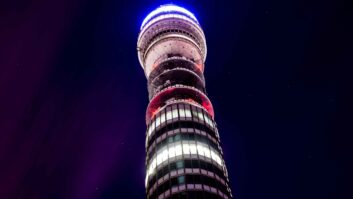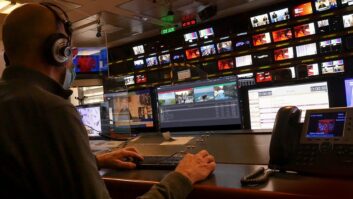Four or five years ago, an exhibitor at IBC booked a lot of poster spaces for a sticker that read, in very large letters, “SDI must die”. Well, that is one view.
SDI is an incredibly successful interconnection technology. It has been adopted universally for digital video, and — within its limitations — it works very well indeed. It has served the industry for more than 30 years and has evolved over that time with a 40X increase in capacity.
Because of this, there is a vast wealth of equipment installed in production and delivery facilities around the world, which talks to other pieces of equipment through these one-signal-per-wire coaxial SDI cables. SDI equipment works.
Establishing the ground rules
Throughout my long career in broadcast, I have learned one universal truth: If a piece of equipment still has an ounce of life left in it, a broadcast engineer will not throw it out. SDI hardware — and SDI itself — still works.
So, my first point is that, despite what some might say, we are not facing a war between the old guard of SDI and the new kids doing IP. Those kinds of words are attention-grabbers on the walls of busy convention centres, but this is not the reality on the ground. It is now the time for the right conversation, about how SDI and IP fit into our future plans.
The second point I make anytime I can is that while sometimes we use the term “IP” for convenience, what I really mean is equipment and architectures conforming to the SMPTE ST 2110 standard, and more broadly ― the AIMS roadmap. As the editor of the standard within SMPTE during its development, I am personally committed to ST 2110. But ST 2110 is the future because it is an agreed standard that the industry has comprehensively backed, and it has been proven through hundreds of high-profile projects.
The media infrastructure evolution
So, if SDI works, what drives a need for IP/2110 in media infrastructures? It is an enabling technology: a new tool for doing things that stretched the bounds of SDI historically.
I noted earlier that SDI works well within its limitations. By that I mean it handles signals up to HD (1080p) very well, with excellent cable reach and plenty of fibre options. Beyond that, there are limitations – 12G SDI for UHD is a great interconnection within a rack or a flypack, but the reach is a bit shy for a big facility. Additionally, the scalability of 12G SDI routing systems is limiting for a large facility. As content production and distribution evolves into UHD and HDR at scale, SDI will not do it for us ― or only with problematic workarounds.
The nature of SDI crosspoint routing has some built-in breakpoints. If you have designed a system around, say, a 288 x 288 SDI router, then as sure as the sun rises in the morning, someone will discover a pressing need for a 289th source. Once again you are facing workarounds and production limitations. Then someone will need a 290th source, and so on. Meetings are held and shouting matches happen over the allocation of router ports in an SDI facility.
One of the widely acclaimed benefits of SDI is that it carries audio embedded in it, so it stays together and stays in sync ― which is fine in parts of the media workflow where the audio is actually tightly bound to the video. But in production, the audio is just as often produced separately, and then re-united with the video right at the end of the chain. So in the production workflow, you have to add a stage that pulls the audio streams out of the video, maps them into (typically) MADI transport and takes them out to the audio room. Mixing and merging alongside all the other audio processes happens there, and then back through MADI to re-embed the audio streams (hopefully still in sync and only a little bit late) in every place where you need to hand off video with audio.
The complexity of embedders and de-embedders — their care, feeding and constant tweaking of delays — is the reality of daily life in production today. It’s a source of unnecessary complexity that translates into errors and scaling challenges.
Real estate economics
SDI with embedded audio is clearly the evil we know, but it’s still sometimes nefarious. When do we need to think about changing up? Where does the conversation around IP start?
The decision to build out new facilities from scratch at greenfield sites is often driven by real estate economics, workforce considerations, and other non-technical factors. Today, there are many new, large-scale production and delivery facilities around the world designed to operate at a scale and interconnectedness that would have been unthinkable with SDI alone. Even the typical new “large” OB trucks being built today have staggering numbers of sources and destinations and a need to support UHD and HDR ― requirements that push well past the limitations of SDI.
If you are starting with a blank sheet of paper, like these projects did, then you have to consider what will and could happen in the future. Consumer transmission of UHD, for example, feels a long way away — until it’s not. But just like the early days of HD (while consumers were still viewing 99 per cent of content in SD), UHD for production is here today, with the collateral benefits of higher resolution, improved gamut and HDR. Producing in UHD and HDR makes a better original, even if the distribution is “only” HD. Content produced in UHD and HDR today will have a longer repurposing life, into more formats than HD, while looking better getting there.
Delivering across platforms
Talking of online, any new production facility will not just be creating and delivering material to a linear broadcast channel. Viewers expect to be able to watch over the air or on the device (and resolution) of their choosing, either as it happens or whenever they want to watch. That means multiple outputs and multiple versions — and would have required an explosive growth of router ports in a traditional SDI workflow.
All said, for any new facility, one must guess what the future holds and then be reasonably ready for it. SMPTE ST 2110-based IP works today and passes the test of being reasonably ready for UHD, HDR, and scale-up.
There is another column on the scorecard for flexibility. In SDI, equipment is frequently built into “chains” to reduce the number of router ports. But in an IP environment, everything connects through the switches, so every interconnection point is essentially a routing point — maintenance and sparing can become a route-around. Reorganising to a new workflow is just routing. At least it is when you have an ST 2110 architecture. Rather than being bound by a fixed number of crosspoints and a limited number of roads leading back to the router, you have a network topography that can reasonably grow and is bound by bandwidth, not switchports. The separation of video, audio, timing and data signals sharing a common fabric enables each device to only get the signals it needs for a given job.
Even greenfields are not entirely green
Every operation today needs to have an opinion about UHD and how they could do it. Special projects can crop up that will likely require UHD or HDR at some point soon. Special projects beget special channels, and soon the experiment becomes the requirement. Recent global events have caused some delay, but it seems inevitable that one day, some sports rights-holders or high-profile events will insist on coverage in UHD and HDR. ST 2110 provides the infrastructure capability to meet the demand.
But here is the important point. As broadcast engineers, thinking ahead and anticipating the emerging requirements is part of the job – the idea of adding capabilities to existing infrastructures has always been at the heart of what we do. And we can still do that.
For greenfield projects, the scale and possibility of SMPTE ST 2110 architecture is manifest — but even greenfield sites are not entirely green. For economic reasons, even greenfield projects tend to bring in some legacy kit, e.g., we might have bought a new set of studio cameras only a couple of years ago.
Greenfields are a luxury, not the norm — infrastructure refreshes and upgrades are the reality — and indeed a real necessity. A common approach is to add ST 2110 islands and beachheads as you redevelop your legacy architecture, gradually moving toward IP, but interconnected with the SDI plant of today. All this works perfectly well, because SMPTE designed ST 2110 to make interoperability reasonable with SDI.
Time for a new metaphor
The war metaphor between SDI and IP was never appropriate. I am certain there will still be significant amounts of SDI equipment in operation the day I retire from this industry. But television engineers are not afraid of the new – in fact, television engineering over the last 30 years has been a constant integration of new technologies and development of new “normals”.
Today, ST 2110 technology is widely available from all the vendors you are likely to deal with, and it is field proven — not a science experiment. Major systems integrators the world over all have experience in building systems based on SMPTE ST 2110. At this point, there is plenty of expertise to lean on, but ultimately it is down to you.
What are your requirements? How much flexibility do you need to build into your architecture decisions? What combination of SDI and IP is appropriate for your next project? Answering these questions will help you maximise the life of your SDI investments and transition to IP at whatever pace works with your business.







